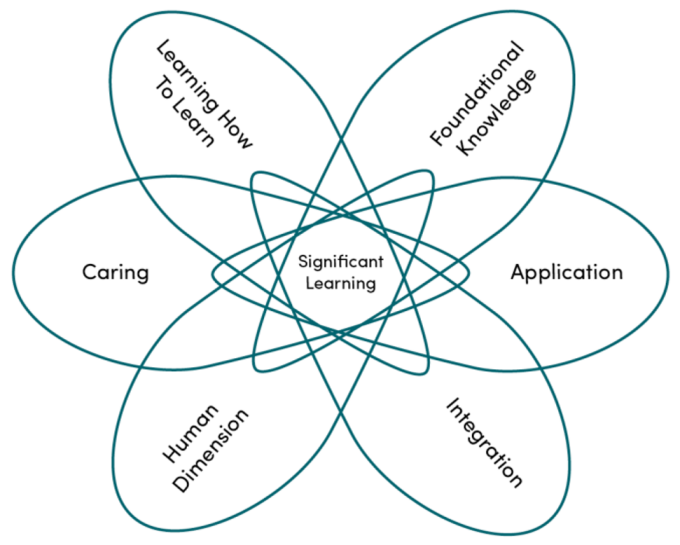Fink's Significant Learning Outcomes
Organizing learning outcomes by more than cognitive complexity.
On this page:
Often, instructors want students to do more than know content that is increasingly complex. Other goals may refer to students’ interaction within the larger program or within the world. Fink (2013) groups this larger learning focus into six groups, which he calls significant learning categories. Use these categories to analyze a course’s current learning outcomes to determine if there are categories that are either over or underrepresented.

Adapted from Fink 2013
Foundational Knowledge
Remembering and understandings information. Other kinds of learning will build off of this base of content knowledge.
Application
Learning a new action, whether a new skill, way of thinking or how to manage projects.
Integration
Making connections between ideas, learning experiences or subject areas. These are often the deeper underlying rules or processes that connect what may at first appear to be disconnected phenomena.
Human Dimension
Learning about yourself and others. This may mean how the material applies to students and those around them, how accomplishing a task or difficult project might reflect on the student (self-image), or what these accomplishments might mean for their future goals (self-ideal).
Caring
Developing interest or value for the topic within students. If you have chosen a topic to teach because it is important, often you will want students to develop a similar appreciation.
Learning How to Learn
Improving students’ learning skills while simultaneously learning content. This means that students are not only becoming more efficient at learning but becoming self-directed to continue learning beyond the course.
A few things to note about these categories.
- Interactive
Learning goals may overlap or build off of each other. For example, as a student learns more about how the topic applies to their community (human dimension) they may also learn to appreciate the topic itself (caring). - Variety
Because learning in one category may support learning in another, try to include a variety of categories. For example, if students understand how a topic contributes to their learning (caring) they may be more interested in learning more (foundational knowledge).
Questions to Consider
Fink (2013) recommends thinking about the impact you want to have on students after they have finished the course. Use the following table as a guide to think of learning outcomes and goals for each category.
| Significant Learning Category | Questions to Ask |
|---|---|
| Foundational Knowledge | What key information (facts, terms, formula, concepts, relationships…) is important for students to understand and remember in the future? |
| Application | What kinds of thinking are important for students to learn here:
What important skills do students need to learn? What complex projects do students need to learn how to manage? |
| Integration | What connections (similarities and interactions) should students recognize and make…
|
| Human Dimension | What can or should students learn about themselves? What can or should students learn about interacting with people that they may actually encounter in the future? |
| Caring | What changes would you like to see in what students care about, that is, any changes in their…
|
| Learning How to Learn | What should students know about learning…
|
Adapted from Fink 2013.
To create a variety of appropriate learning outcomes for students:
- Use the verb chart below to categorize your learning outcomes by Fink’s six levels.
- Determine which levels are appropriate for your course and which are missing.
- Adjust or create new outcomes using this verb chart by choosing new verbs in the appropriate categories. Are these balanced?
- Fink, L. D. (2013). Creating significant learning experiences: an integrated approach to designing college courses (Revised and updated edition). San Francisco: Jossey-Bass.